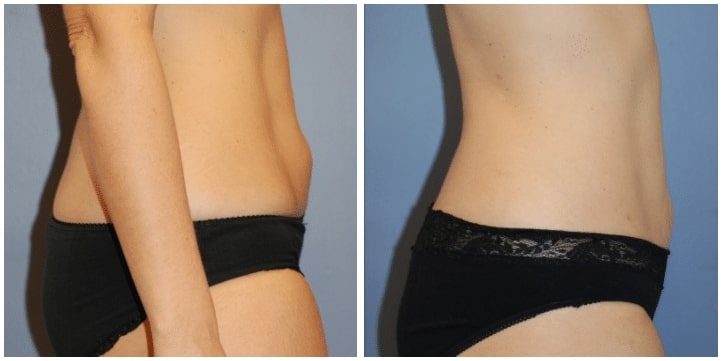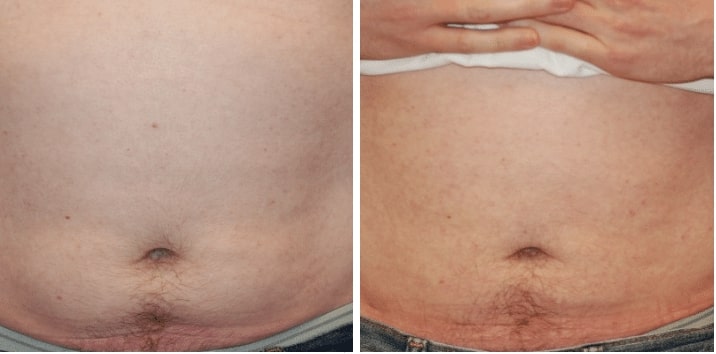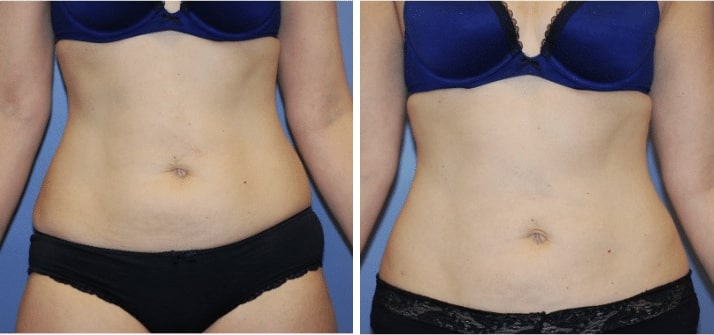Liposuction can allow you to reach your ideal figure when diet and exercise fail to eliminate stubborn body fat. Liposuction is a procedure, for men and women in Boston, that removes fat deposits present under the skin from different parts of the body using a vacuum-suction cannula (a hollow pen-like instrument). Dr. Samuel Lin and his team understand that each patients journey to achieve their desired body shape is unique and are genuinely invested to ensure you receive exceptional results. Schedule your liposuction consultation in Boston to learn more about this life changing procedure.

Dr. Lin Testimonials
Reasons For Considering Liposuction
- Eliminate fat from any of the following areas:
- Back
- Upper Arms
- Stomach and Waistline
- Hips and Buttocks
- Thighs and Knees
- Calves and Ankles
- Create a more proportional figure
Liposuction Before & After
Liposuction is not an alternative for proper exercise and diet. Furthermore, although it can alter the shape of your body, if cellulite is present, any surface irregularities will not be changed.
What Is Liposuction?
Liposuction is a type of surgical procedure in which (excess) fat is broken up and eliminated from the body for reshaping or slimming. This can be performed in a range of body regions, from the breasts, abdomen, hips, thighs, buttocks, back, to arms. Traditionally, small cannulas, or blunt tubes, are inserted through small incisions and used to suction out the fat. Current methods include tumescent, ultrasound, or laser- assisted liposuction. Tumescent liposuction consists of fluid through local anesthetic/pain medication being used preoperatively and injected into the fat before suctioning. Ultrasound and laser-assisted liposuction may be useful to help liquefy fat before suctioning.
General Procedure For Liposuction
This procedure can take thirty minutes to several hours depending on the amount of fat to be removed. A small incision is created through which a narrow tube or “cannula” is inserted and used to vacuum out the fatty tissue beneath the skin. The amount of fat removed is determined by the surgeon. Following removal of excess fat, incisions are closed and the dressing consists of applying a compression dressing or bandage to the area.
Anesthesia For Liposuction Procedure
General or local anesthesia with sedation medication.
Recovery Process For Liposuction In Boston, MA
Recovery time is dependent on the extent of the procedure. The first one to two hours following surgery are spent in the recovery room. In order to speed up the healing process, rest and limited movement are advised. An elastic garment or body stocking will be worn over the treated area for two weeks. Patients may report pain following surgery which can be treated with oral medication. Although the occurrence of complications is rare, Dr. Lin’s patients in Boston can reduce the risk of developing potential problems after their liposuction procedure by carefully following the post-operative instructions.
How Long Do The Results Last?
Results are variable depending on the patients’ adherence to diet and exercise. It is key to remember that liposuction is not a replacement for weight loss! Rather, it is used to reshape the body. The fat removed from liposuction is permanent, and as such, if the patient eats and exercises according to his/her new body shape, it should last. However, if the patient does not maintain weight according to his/her new body shape, then fat will return, affecting body shape and the duration of results.
One common misconception is that liposuction is a solution to obesity. Patients should be aware that liposuction is a procedure for body shaping, whereas dieting and exercise should be the means to weight loss. Moreover, optimal outcomes for liposuction are found when patients are within their optimal weight range and simply require removal of excess fat deposits. Another fact patients should be aware of is that improved body contour may be difficult to fully appreciate in the immediate postoperative period. This is due to swelling and fluid retention, which should subside over time.
How Much Does Liposuction Cost?
A definite answer to the cost is sometimes difficult to determine, primarily due to variations based on the type of procedure, location of sites for liposuction, and regional differences. In addition, prices differ depending on body area, with some of the common regions being the abdomen, hips, arms, thighs, or buttocks. I would say that a ballpark estimate of $3,000-$12,000 may encompass the range of costs patients may encounter depending on the patient. An important factor is not to solely base the decision on cost and to find a board certified plastic surgeon both for safety and for optimal outcomes.
Is Liposuction Safe?
For the most part in the vast majority of patients, liposuction is considered a safe procedure if performed by an experienced, board certified plastic surgeon and if the patient is in a healthy state. However, as with any procedure, there are always inherent risks of undergoing surgery. Risks for complications increase when liposuction is done extensively for large amount of fat or if the above-mentioned criteria are not met.
Dangerous complications can consist of death, fat/blood clots, or puncture of vessels or organs. Patients should be assured that if they find a reputable board certified plastic surgeon that there should be appropriate pre-operative screening to determine risks, based off evidence-based medicine, to minimize any complications.
Before & After Photos
Liposuction FAQS
First off, it’s important to remember that liposuction is not a weight-loss procedure. Liposuction is meant to remove unwanted pockets of fat that tend to accumulate in areas that are resistant to dietary changes or exercise. These pockets are common on the lower abdomen, the upper thighs, the jowls, and other areas of the body. Liposuction removes these pockets of fat, slimming the contour. This is a body-contouring procedure.
Excellent candidates still have good elasticity in their skin. This enables the skin to easily tighten down to the slimmer contour once the underlying fat is removed. If the potential patient has sagging, stretched, loose skin, liposuction alone is not the best procedure, as it will leave an area of loose sagging skin, albeit with less fat underneath. In these cases, procedures that remove excess skin, such as a tummy tuck or an arm lift, are better options. Dr. Lin may combine these procedures with liposuction if appropriate.
Otherwise, just about everyone, no matter what kind of shape they are in, has pockets of stubborn fat that they would like to remove. Liposuction is perfect for the job.
The pain that follows liposuction is not acute or sharp pain; it is usually equated to more of a severe muscle ache type of pain. The discomfort will be most evident in the first two to three days, although you won’t need to be in bed. Pain medication will handle this. In cases where only a small area was treated, the pain is minimal. You’ll still want to lay low for a day or two in most cases, however.
The duration of the liposuction session with Dr. Lin is completely dependent upon the area or areas being treated. If you’re having a small area, such as under your chin, worked upon, the procedure may take just 30 minutes or so. Larger areas or multiple areas can take a couple of hours.
The preparations for this procedure are the same as with any surgery. You’ll need to stop taking aspirin or other anti-inflammatory medicines, as they can increase bleeding and subsequent bruising. You’ll need to stop smoking for at least two weeks prior to your procedure and two weeks afterward because smoking can inhibit healing. You’ll need to arrange to have someone drive you to and from the surgery center. It’s also a good idea to have someone around your house or apartment for the first day after your liposuction.
Dr. Lin emphasizes here that liposuction is not a quick weight-loss panacea. He requires his liposuction patients to be within 10 percent of their ideal body weight to qualify for this procedure. Every patient’s situation is unique, so you cannot set an arbitrary number of pounds of fat to be removed. There is an accepted limit for a single surgical session of 6000 ml. This includes the fat cells, blood, and tumescent solution and it equals a total of 12 pounds of fat and fluid. But this does not mean 12 pounds of fat will be removed. Actually removing too much fat is dangerous to the patient. Dr. Lin uses the patient’s body mass index as a starting point to then set a limit on fat to be removed. The real goal is to create a slimmer contour, and he removes the fat necessary to do so.
Loose skin following liposuction can be a concern, especially if too much fat is removed from an area. This is more of a problem if the patient had loose skin before undergoing liposuction. Diligent wearing of your compression garments will help the skin settle and tighten down to its new slimmer contour.
Prior to liposuction, Dr. Lin will check the elasticity of your skin in the target area. Liposuction on the outer thighs rarely has a problem with loose skin. The inner thighs and upper arms can be more problematic, but Dr. Lin’s expertise can still make the procedure work in these areas. If you’re targeting your abdomen, and you have loose skin from pregnancy and childbirth or from a large gain and subsequent loss of weight, Dr. Lin may recommend performing a tummy tuck combined with liposuction to remove the unwanted pockets of fat and to trim away the excess skin and reposition separated stomach muscles.
Schedule A Client Consultation
Contact Lin Plastic Surgery today to schedule your consultation for liposuction at our Boston practice by calling 617.632.7827 today!




